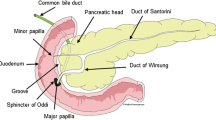Abstract.
The aim of this study was to clarify the characteristics of pancreatic head carcinomas mainly invading the groove between the duodenum and the pancreatic head. Nine patients with pathologically proven pancreatic head carcinomas underwent thin-slice dynamic CT, MR imaging, duodenal endoscopy, and angiography (seven patients). Plate-like masses within the groove region were seen in all cases, which showed hypointensity on T1-weighted images and slight hyperintensity on T2-weighted MR images. The masses appeared hypovascular in the early phase and delayed enhancement in the late phase of dynamic CT and MR imaging. On MR cholangiopancreatography, stenosis of intrapancreatic common bile duct was seen in all patients, whereas stenosis of the main pancreatic duct was seen in only three cases. Endoscopy revealed luminal narrowing of the duodenum in all patients, and duodenal mucosal biopsy demonstrated adenocarcinoma in seven patients. Abdominal arteriography showed serrated encasement of peripancreatic arteries in seven patients who received angiographic examinations. The CT and MR imaging findings of groove pancreatic carcinomas resemble those of groove pancreatitis. Differential diagnosis may be achieved by the pathological diagnosis of a biopsy specimen of the duodenal mucosa and arterial encasement on arteriography.





Similar content being viewed by others
References
Stolte M, Weiss W, Volkholz H et al. (1982) A special form of segmental pancreatitis: "groove pancreatitis". Hepatogastroenterology 29:198–208
Becker V, Mischke U (1991) Groove pancreatitis. Int J Pancreatol 10:173–182
Tio TL, Luiken GJ, Tytgat GN (1991) Endosonography of groove pancreatitis. Endoscopy 23:291–293
Shudo R, Obara T, Tanno S et al. (1998) Segmental groove pancreatitis accompanied by protein plugs in Santorini's duct. J Gastroenterol 33:289–294
Fujita N, Shirai Y, Tsukada K et al. (1997) Groove pancreatitis with recurrent duodenal obstruction. Report of a case successfully treated with pylorus-preserving pancreaticoduodenectomy. Int J Pancreatol 21:185–188
Procaccci C, Graziani R, Zamboni G et al. (1997) Cystic dystrophy of the duodenal wall: radiologic findings. Radiology 205:741–747
Vullierme MP, Vilgrain V, Flejou JF et al. (2000) Cystic dystrophy of the duodenal wall in the heterotopic pancreas: radiopathological correlations. J Comput Assist Tomogr 24:635–643
Yamaguchi K, Tanaka M (1992) Groove pancreatitis masquerading as pancreatic carcinoma. Am J Surg 163:312–316
Scapa E, Broide E, Halevy A et al. (1994) Groove pancreatitis and adenocarcinoma of the pancreatic head. Harefuah 127:161–162
Wapnick S, Hadas N, Purow E et al. (1979) Mass in the head of the pancreas in cholestatic jaundice: carcinoma or pancreatits? Ann Surg 190:587–591
Itoh S, Yamakawa K, Shimamoto K et al. (1994) CT findings in groove pancreatitis: correlation with histopathological findings. J Comput Assist Tomogr 18:911–915
Irie H, Honda H, Kuroiwa T et al. (1998) MRI of groove pancreatitis. J Comput Assist Tomogr 22:651–655
Gabata T, Matsui O, Kadoya M et al. (1994) Small pancreatic adenocarcinomas: efficacy of MR imaging with fat suppression and gadolinium enhancement. Radiology 193:683–688
Johnson PT, Outwater EK (1999) Pancreatic carcinoma versus chronic pancreatitis: dynamic MR imaging. Radiology 212:213–218
Furukawa H, Takayasu K, Mukai K et al. (1996) Late contrast-enhanced CT for small pancreatic carcinoma: delayed enhanced area on CT with histopathological correlation. Hepatogastroenterology 43:1230–1237
Fischer U, Vosshenrich R, Horstmann O et al. (2002) Preoperative local MRI-staging of patients with a suspected pancreatic mass. Eur Radiol 12:267–269
Author information
Authors and Affiliations
Corresponding author
Rights and permissions
About this article
Cite this article
Gabata, T., Kadoya, M., Terayama, N. et al. Groove pancreatic carcinomas: radiological and pathological findings. Eur Radiol 13, 1679–1684 (2003). https://doi.org/10.1007/s00330-002-1743-1
Received:
Revised:
Accepted:
Published:
Issue Date:
DOI: https://doi.org/10.1007/s00330-002-1743-1




